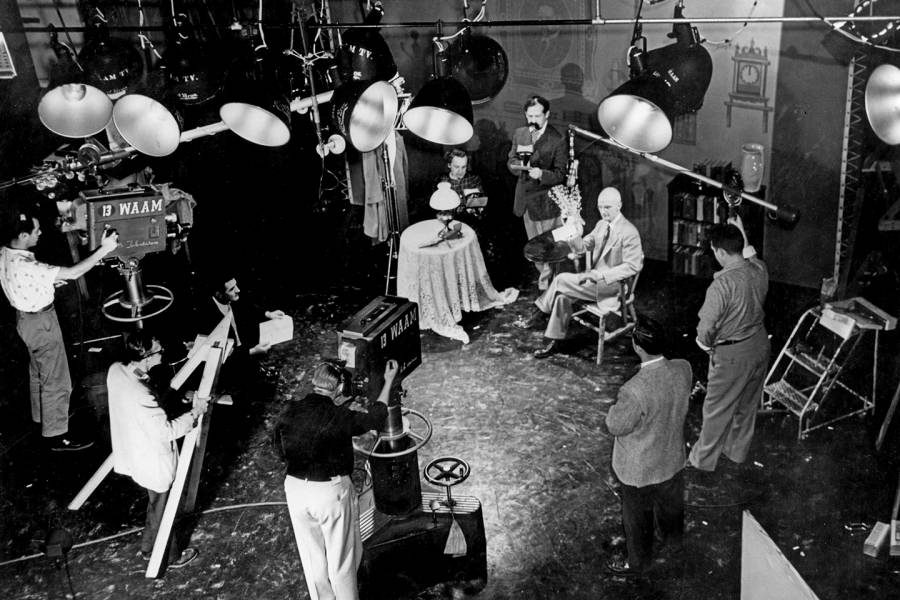Reboots are not uncommon in the world of television. Think of how many versions of Star Trek are out there. But a group of Johns Hopkins communicators and filmmakers—concerned with science facts, not science fiction—is taking this concept to the extreme.
Seventy-five years ago, the university pioneered science television with The Johns Hopkins Science Review, whose half-hour, black-and-white broadcasts aired nationally on CBS throughout the Eisenhower era. Each promised an "over the shoulder" look at the latest scientific research. A little over half of the shows have survived and are archived.
Inspired by this groundbreaking program, the goal is to return Hopkins research to the nation's TV screens through a slick, science-focused series available via a streaming service such at Netflix. Its working title: Wavelengths.
"The Science Review has been interesting to a lot of people for a while now, as its just kind of a gold mine and a wonderful look back in history," says Annette Porter, a documentary filmmaker working on the project and co-director of the JHU-MICA Film Centre. "The idea now is to respond to this increasing distrust of science and the scientific process. What do we have to say about that as a science institution? And so, we wanted to make a new series about science and the science being done at Hopkins."
Backed by a 2023 Discovery Award from the university, the first goal of the Wavelengths TV team—composed of staff from the Johns Hopkins University Press, the Department of Film and Media Studies, and the Office of Research—is to create a 5-minute proof-of-concept promotional video with accompanying marketing materials. These will to be used to pitch the creation of a series of 20-minute episodes to producers and executives at Netflix, HBO, Disney+, Discovery, and others. "Our goal is to really showcase the idea in such a way that people say, 'Wow, this needs to be made, we're on board, and it needs to be done at Hopkins,'" Porter says.
The team has already begun interviewing some of the scientists whose projects they hope will convey "the awe of science" in the teaser video. These include planetary scientist Elizabeth Turtle, whose Dragonfly project at the Applied Physics Lab is creating a drone-like helicopter to explore the surface of Saturn's largest moon, Titan, and robotics professor Jim Bellingham, a pioneer in the world of marine robotics and director of the Institute for Assured Autonomy. Psilocybin research and the groundbreaking work of the School of Medicine's Center for Psychedelic and Consciousness Research is another topic of interest.
The filmmakers are eagerly looking for more subjects to interview; researchers who want to nominate themselves or others for inclusion are invited to fill out a questionnaire.
The program takes its placeholder title from the Wavelengths science communication initiative created by JHU Press and the Office of Research in 2020 to present the work of the Bloomberg Distinguished Professors to general audiences. Topics for its seven book titles available so far include artificial intelligence, cancer, and health equity; Sabine Stanley's What's Hidden Inside Planets? will be released next month.
Video credit: Johns Hopkins University
Anna Marlis Burgard leads the Wavelengths program as director of strategic engagement for the Office of Research and is a creative producer for the proposed TV series. She says The Johns Hopkins Science Review came up in meetings her office had with colleagues from the film and media department to discuss new ways to present Hopkins research to the wider public.
"I didn't know the series existed," Burgard says. "But others on the team knew of it and were excited to explore a new iteration. They shared links to the original episodes, and it quickly became the central point of conversation. Its pioneering spirit is now a through line from that era to today."
The Johns Hopkins Science Review debuted in 1948, when perhaps fewer than 250,000 TV sets were in use nationwide. Each episode dealt with a specific scientific or research theme—cancer, plastics, atomic energy—and featured Hopkins scientists and guests from other institutions. Bespectacled host Lynn Poole, the university's first director of public relations, created the show and was the concept's chief cheerleader. It was a low-budget, low-tech affair filmed live on the giant cameras of the age while employing homespun props of plywood and papier-mâché. Nevertheless, it won a pair of prestigious Peabody Awards for broadcast excellence and was widely lauded in the national press for its educational content—all while losing badly in the ratings against splashy offerings from celebrities such as Milton Berle.
The show's name and content were tweaked a few times before university leadership pulled the plug on its involvement with television in 1960. The 303 surviving episodes were languishing on decaying 16mm films until grant funding secured in 2003 allowed them to be digitized.
"It would be fun to use little snippets of the Science Review in each new episode," Porter says. "I think people like watching archival footage. You get to see how science changed over time, and it also establishes Hopkins as a very long-term expert."
Indeed, space exploration was in its infancy when Poole had famed rocketeer Wernher von Braun on to discuss its possibility in 1952. There was reverent and tantalizing talk of one day going to the moon. Today, not only do Hopkins scientists aim to land a high-tech helicopter on Saturn's moon, but last fall researchers here worked with NASA on the DART project, which successfully fired a projectile at an asteroid some 7 million miles away and altered its trajectory.
The reboot will not only show how science has changed over the decades, but also the scientists themselves, who are almost exclusively white men in Science Review footage. "The researchers and scientists we're talking to are diverse," Porter says. "We have men and women and diversity in age and race. That's a great story, too."
Posted in Arts+Culture, Science+Technology
Tagged film and media studies, television, johns hopkins science review









